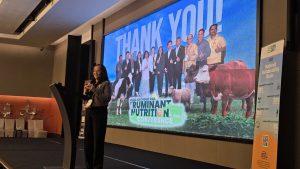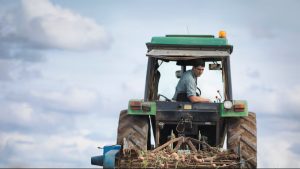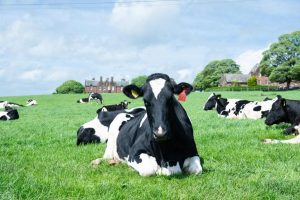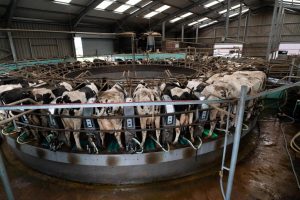
Franklin Turner of East Stibb farm in Devon has been taking his cows inside in the middle of the day to cool them down. The 70-strong dairy herd are milked in the morning and put out to the fields before they are brought back inside to avoid the blazing mid-day sun.
“It has been 36 degrees near here, the hottest we have had it,” explained Mr Turner. “Before the heat is going, I do the milking first time on the farm and turn them out. Then my dad takes them inside before lunchtime and out of the sun.”
The 70-acre farm is parched after a dry summer leaving no grass in the fields. “I have been feeding a full winter ration to the cows this last month. They come into feed on the silage in the yard then head back to the fields to lie down. We have a lot of tree cover at the edge of our big fields so they tend to lie under them.
“I managed to carry 200-250 bales from last year, so I am lucky in that respect. What with fertiliser prices this year, I have bought very little. What I have saved on fertiliser I am eating in silage now. We made good silage this year and averaged around four and a half bales to the acre.”
It is not just the price of fertiliser which has jumped for the third-generation farmer, but also feed which now costs £400/t. However, Mr Turner does point out that his milk price is 47p/litre from his buyer who makes milkshakes. With the herd averaging 25 litre of milk per cow per day, Mr Turner feels there is a margin still to be made.
Further east at Oak Bank dairy farm near Ashburnham in East Sussex, Louke van der Meer has taken to keeping his cows in woodland during the day. On the 450-acre farm the 145 Holstein cross Friesian cows are spending the middle of the day shaded by three quarters of an acre of woodland.
“We are trying everything to combat the heat,” explained Mr van der Meer. “Right now it is 35 degrees and I have seen the car thermometer tell me it 40. We usually milk at 3pm but we are keeping them in the woods near the water trough until 5pm when it is safe to take them inside.”
The herd has already had one white cow which collapsed with heat stroke. The poorly animal is now covered by a gazebo in the field getting regularly drenched with water to cool her down.
This is not the first time the second generation farmer has had to combat dry conditions and extreme heat. He said: “Four years ago we had nine weeks without rain and it was very hot with field fires on the neighbouring arable farms. That summer we took the cows indoors during the hottest week. But the conditions in the shed was still stifling and some of the cows were being sick with the heat stress – that is something I will never forget.
“So this year I wanted to keep the cows out in the shade where they can get a breeze. We have this wood which is an old iron ore pit which floods in the winter but is dry in summer surrounded by 25 acres of grass. They were initially reluctant to come into the trees but a bucket of concentrate and some wet third cut silage from last year got them under the leaves.
“So far it has worked well with very little drop in milk yield. Per lactation we would be expecting to get between 7500 to 8000 litres of milk. Once the heat drops a bit, we will start housing the cows at night to get more dry matter into them to keep them going. We run sheer grabs and bales of silage as opposed to a TMR on the farm.”
Dairy farming is going through challenging times according to Mr van der Meer. “We are now getting 40p per litre and received our biggest price rise ever when it jumped 4ppl. But the next day the price of feed followed suit so any potential margin was wiped out.
“Four years ago we were getting 36ppl for our milk, but the costs were nowhere near what they are now – it was much more profitable then.”

























